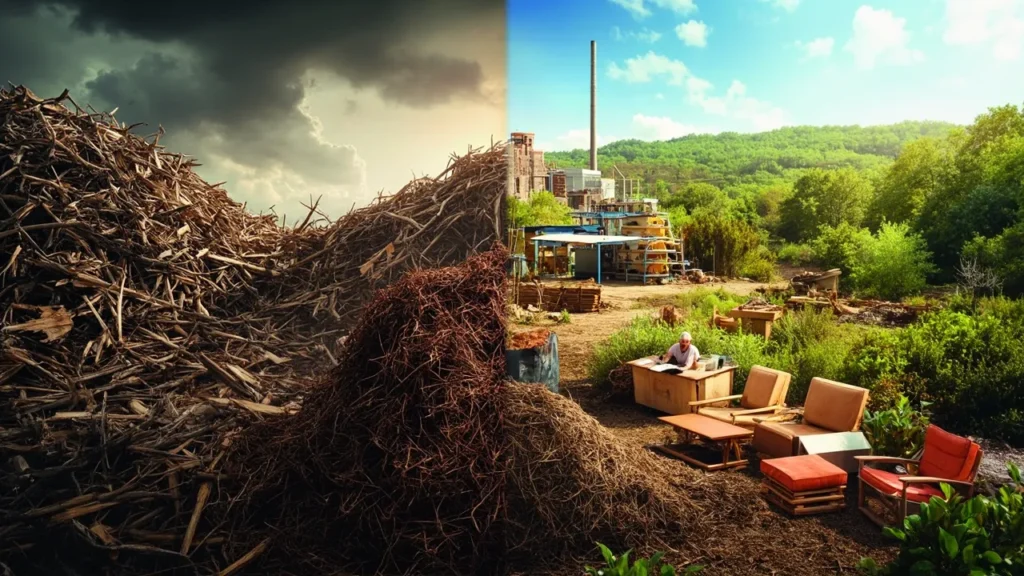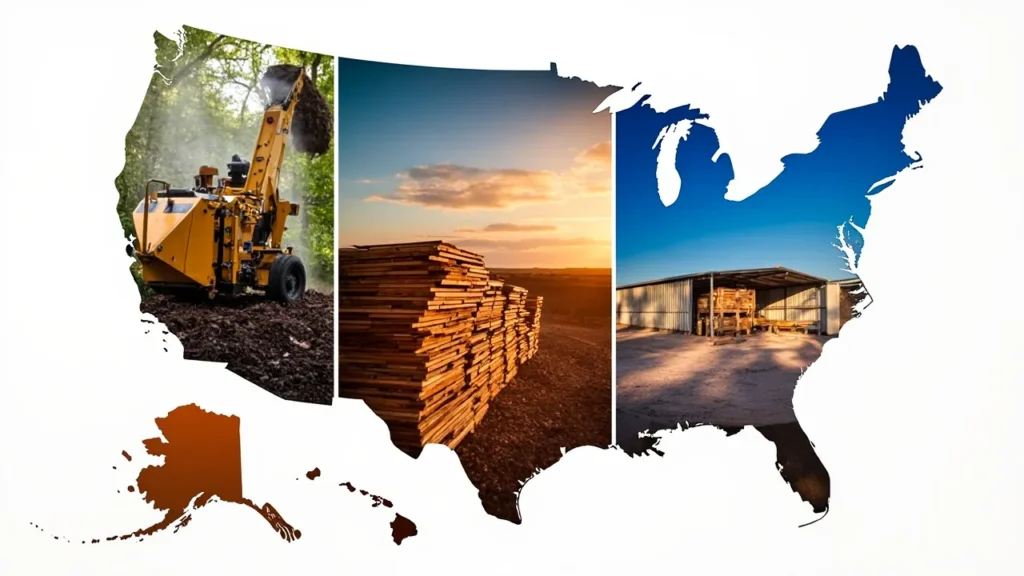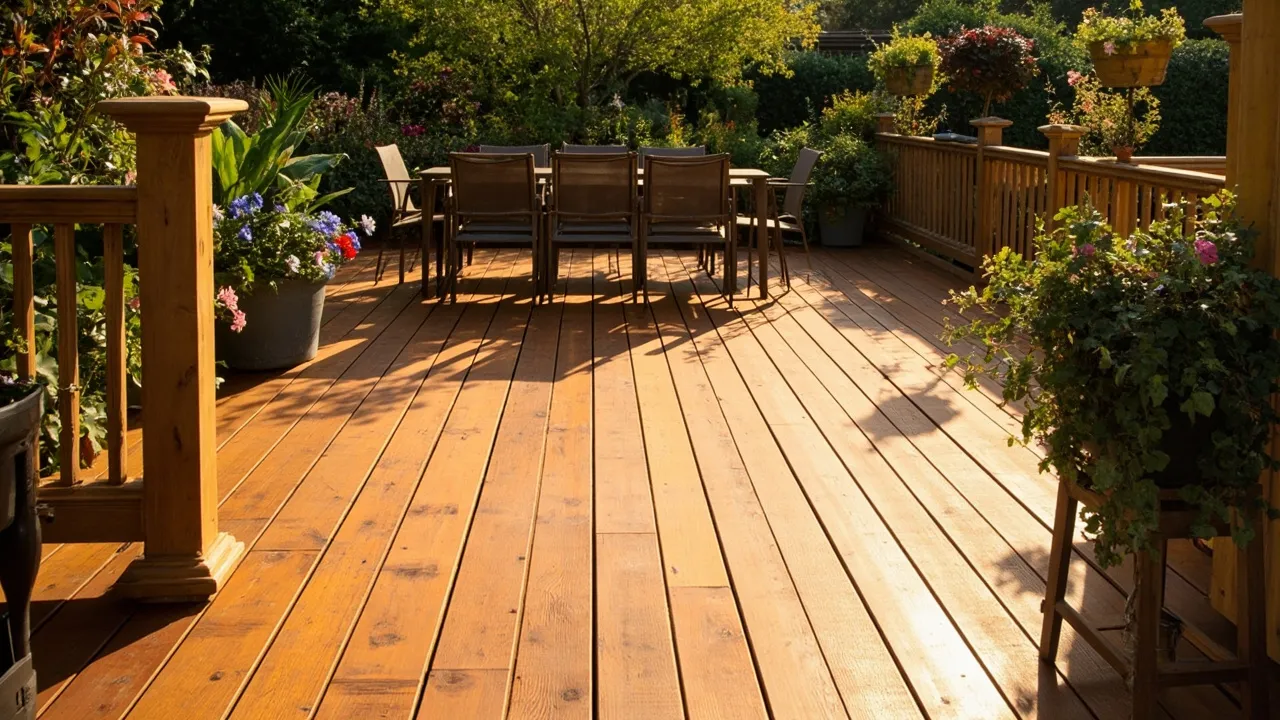The Critical Need for Sustainable Wood Waste Management

Every year in the United States, approximately 36 million tons of wood waste end up in landfills – enough to build 300,000 average-sized homes. This staggering statistic highlights why adopting sustainable wood waste recycling methods isn’t just an option, but an environmental imperative.
Table of Contents
As someone who’s worked in sustainable construction for over a decade, I’ve seen firsthand how simple changes in our approach to wood waste can create significant positive impacts. Whether you’re a DIY enthusiast with occasional wood scraps or a construction professional managing job site waste, understanding sustainable wood waste recycling methods can transform your environmental footprint while often saving money.
Understanding Wood Waste: Types and Environmental Impact
Categories of Wood Waste
- Clean Untreated Wood
- Lumber cut-offs
- Pallets and crates
- Natural wood debris (branches, stumps)
- Sawdust and wood shavings
- Treated Wood Products
- Pressure-treated lumber
- Painted or stained wood
- Composite wood materials
- Railroad ties and utility poles
- Engineered Wood
- Plywood and OSB
- MDF and particleboard
- Laminated beams
The Hidden Costs of Wood in Landfills
When wood decomposes anaerobically in landfills:
- Produces methane (25x more potent than CO₂)
- Wastes valuable biomass energy potential
- Occupies 18% of landfill space nationwide
- Leaches chemicals from treated wood into groundwater
Recent EPA studies show that implementing sustainable wood waste recycling methods could reduce construction sector emissions by up to 12% annually.
Comprehensive Sustainable Wood Waste Recycling Methods
1. Advanced Repurposing Techniques
Going beyond basic reuse, these innovative sustainable wood waste recycling methods can yield surprising results:
A. Architectural Salvage
- Reclaim hardwood flooring (can be resold for 3−3−8/sqft)
- Save decorative moldings and trim
- Preserve vintage lumber for restoration projects
B. Artistic Upcycling
- Create mosaic patterns from small scraps
- Craft wooden jewelry and accessories
- Build musical instruments from quality cuts
C. Functional Conversions
- Transform pallets into modular furniture
- Convert shipping crates into storage solutions
- Make sawdust into wood filler or paper pulp
Case Study: A Chicago workshop diverted 12 tons of wood from landfills last year by teaching community members these sustainable wood waste recycling methods.
2. Industrial-Scale Composting Solutions
For larger quantities, these sustainable wood waste recycling methods maximize efficiency:
Municipal Programs
- Many cities now accept untreated wood in yard waste
- Commercial compost facilities process wood chips
- Some offer discounted mulch in return
On-Site Systems
- Vermicomposting with wood chips
- Hot composting for faster breakdown
- Static pile methods for large volumes
Technical Note: The ideal carbon-nitrogen ratio for composting with wood is 30:1. Mix 2 parts wood chips with 1 part green waste for optimal results.
3. Community-Based Recycling Networks

Expanding on donation concepts, these sustainable wood waste recycling methods build circular economies:
Online Platforms
- Wood waste exchanges (like Craigslist Free section)
- Material matching services
- Local “buy nothing” groups
Institutional Partnerships
- Schools with vocational programs
- Maker spaces and tool libraries
- Theater set construction teams
Innovative Models
- Wood waste “banks” for community projects
- Shared storage facilities
- Skill-building workshops
4. Advanced Processing Technologies
Modern sustainable wood waste recycling methods include sophisticated solutions:
Mechanical Processing
- Trommel screens for size separation
- Air classifiers for contaminant removal
- Optical sorters for material identification
Chemical Recycling
- Enzymatic breakdown for biofuels
- Pyrolysis for biochar production
- Gasification for synthetic fuels
Emerging Technologies
- Mycoremediation (fungi-based breakdown)
- Nano-cellulose extraction
- 3D printing filament production
Regional Implementation Guide

Northeast Corridor (NY, MA, PA)
Challenges:
- Mixed seasonal weather
- Historic building materials
- Urban density
Sustainable Solutions:
- Specialty salvage yards for antique lumber
- High-efficiency biomass district heating
- Urban micro-mulching programs
Gulf Coast (TX, LA, FL)
Challenges:
- Hurricane debris
- Termite risks
- High humidity
Sustainable Solutions:
- Storm debris processing centers
- Pressure-treated wood recycling pilots
- Coastal erosion control with wood chips
Mountain West (CO, UT, NV)
Challenges:
- Dry climate decomposition
- Remote locations
- Wildfire risks
Sustainable Solutions:
- Fire-resistant landscaping mulch
- Mobile processing units
- Biomass cogeneration plants
Business Applications of Sustainable Wood Waste Recycling Methods
For Construction Companies
Waste Reduction Strategies:
- Pre-cut framing to minimize scraps
- Modular design approaches
- On-site sorting stations
Revenue Opportunities:
- Selling quality cut-offs
- Offering deconstruction services
- Producing branded mulch products
For Municipalities
Program Development:
- Curbside wood waste collection
- Drop-off center optimization
- Public education campaigns
Infrastructure Investments:
- Material recovery facilities
- Biomass energy plants
- Composting operations
The Future of Sustainable Wood Waste Recycling Methods
Innovations on the Horizon:
- AI-powered sorting robots
- Blockchain material tracking
- Self-healing wood composites
- Carbon-negative processing
Policy Developments:
- Landfill bans for untreated wood
- Extended producer responsibility
- Green building certifications
- Carbon credit programs
Getting Started: Your Action Plan
For Homeowners:
- Start a scrap wood inventory
- Identify local recycling options
- Try one simple upcycling project
For Contractors:
- Conduct a waste audit
- Train crew on sorting protocols
- Partner with recycling providers
For Communities:
- Map existing resources
- Identify gaps in services
- Develop collaborative solutions
Building a Wood-Smart Future
The journey toward comprehensive sustainable wood waste recycling methods requires participation at all levels – from individual homeowners to multinational corporations. Each piece of wood we save from landfills represents:
- Carbon kept out of the atmosphere
- Resources conserved for future generations
- Economic value retained in communities
As these sustainable wood waste recycling methods continue evolving, they offer not just environmental benefits, but also economic opportunities and community resilience. The wood waste challenge is substantial, but so is our collective capacity for innovation and change.
FAQ: Sustainable Wood Waste Recycling Methods
Q: What’s the easiest way to start with sustainable wood waste recycling at home?
A: Begin by separating untreated wood scraps from other waste. Keep a bin for small pieces (great for kindling or crafts) and another for larger pieces (potential DIY projects). Many homeowners find making simple birdhouses or garden markers is an easy entry point to sustainable wood waste recycling methods.
Q: Can I put pressure-treated wood in my regular wood recycling?
A: Never mix pressure-treated wood with regular wood recycling. The chemicals (like arsenic in older treatments) contaminate recycling streams. Most communities have special collection days for hazardous wood waste – check with your local waste authority for proper disposal methods.
Q: How small can wood pieces be to still be recyclable?
A: Even sawdust has value in sustainable wood waste recycling methods! Many facilities accept pieces as small as 1-inch, while sawdust can be used for animal bedding, compost additive, or particleboard production. Some specialty recyclers even process wood flour for industrial applications.
Q: Are there any tax benefits for businesses using sustainable wood waste recycling methods?
A: Yes! Several states offer tax credits for wood recycling equipment purchases or waste diversion achievements. The federal government also provides deductions for certain recycling activities. Consult a green business accountant – many businesses save thousands while reducing their environmental impact.
Q: What’s the most innovative wood recycling method you’ve seen?
A: One groundbreaking approach is mycoremediation – using mushrooms to break down treated wood safely. Some facilities are also converting wood waste into biochar (a soil enhancer that sequesters carbon) or nanocellulose for high-tech materials. These advanced sustainable wood waste recycling methods are transforming waste into high-value products.
Q: How can renters participate in wood recycling without tools or space?
A: Excellent question! Many cities have community woodshops where you can bring scraps for shared projects. Others offer “tool libraries” with equipment rentals. For small amounts, consider creative no-tool projects like making wooden coasters (just sand and seal) or donating to local schools’ art programs.
Q: Is burning wood waste an acceptable recycling method?
A: Only for clean, untreated wood in EPA-certified stoves. Burning releases carbon immediately and creates air pollution. Most sustainable wood waste recycling methods like composting or mulching provide better environmental benefits by keeping carbon sequestered longer while improving soil health.
Q: How do I know if my wood waste is too rotten to recycle?
A: Even decayed wood has value! While it might not work for crafts, rotten wood makes excellent compost or biomass fuel. The only exception is wood with active mold/fungus that could spread – in that case, bag it separately and label for proper disposal.
Q: What percentage of wood waste currently gets recycled in the US?
A: Current estimates suggest only about 15-20% of wood waste undergoes sustainable wood waste recycling methods. The construction industry recycles about 30% of its wood waste, while residential recycling rates are much lower – showing huge potential for improvement!
Q: Can I recycle wood with nails or screws still in it?
A: Most professional recycling facilities can handle some metal contamination – their powerful magnets remove nails during processing. However, for small-scale or community recycling efforts, it’s considerate to remove hardware when possible. The nails can often be recycled separately as scrap metal!
“Begin today by examining your next wood waste stream – what single improvement can you implement this week to advance your sustainable wood waste recycling methods?”







